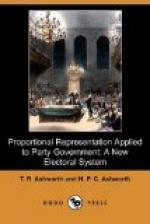It might be provided, however, for greater accuracy that all papers contributing to surpluses on the first count only should be transferred in packets. Should these contribute to a new surplus, it should be divided into two parts, proportional to (1) original votes and votes transferred from excluded candidates, and (2) the value of the packet in votes. Each part would then be distributed proportionally to the next available preferences wherever expressed. To divide the packets into sub-packets is a useless complication. The loss involved in neglecting them would usually be less than one-thousandth part of the loss due to exhausted papers.
Having now dealt with the main features of the different variations of the Hare system, we may proceed to consider some details which are common to all of them. A difference of opinion exists, however, as regards the quota. Sir John Lubbock and Professor Nanson advocate the Droop quota, which we have shown to be a mathematical error; Miss Spence and Mr. Clark use the correct quota.
+The Wrong Candidates are Liable to be Elected.+—The Hare system may be criticised from two points of view; first, as applied to the conditions prevailing when it is introduced, and, secondly, as regards the new conditions it would bring about. Its advocates confine themselves to the first point of view, and invariably use illustrations based on the existence of parties.
We readily grant that if the electors vote on party lines, and transfer their votes within the party as assumed, the Hare system would give proportional representation to the parties; but even then it would sacrifice the interests of individual candidates, for it affords no guarantee that the right candidates will be elected. The constant tendency is that favourites of factions within the party will be preferred to general favourites. This at the same time destroys party cohesion, and tends to split up parties. Nor can this result be wondered at, since the very foundation of the system is the separate representation of a number of sections.
One reason why the wrong candidates are liable to be elected is that the electors will not record their honest preferences if the one vote only is effective. They will give their vote to the candidate who is thought to need it most, and the best men will go to the wall because they are thought to be safe. Mr. R.M. Johnston, Government Statistician of Tasmania, confirms this view when he declares—“The aggregate of all counts, whether effective or not, would seem to be the truer index of the general favour in which each candidate stands, because the numbers polled at the first count may be greatly disturbed by the action of those who are interested in the success of two or more favourites who may be pretty well assured of success, but whose order of preference might by some be altered if sudden rumour suggested fears for any one of the favoured group. This accidental




